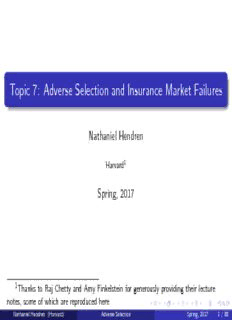
Topic 7: Adverse Selection and Insurance Market Failures PDF
Preview Topic 7: Adverse Selection and Insurance Market Failures
Topic 7: Adverse Selection and Insurance Market Failures Nathaniel Hendren Harvard1 Spring, 2020 1Thanks to Raj Chetty and Amy Finkelstein for generously providing their lecture notes, some of which are reproduced here NathanielHendren (Harvard) AdverseSelection Spring,2020 1/88 Social Insurance The government is a large provider of social insurance Health Insurance (Medicaid, Medicare) Unemployment insurance Disability insurance Annuities (Social security) Why does the government provide this insurance? Why not private markets? NathanielHendren (Harvard) AdverseSelection Spring,2020 2/88 Adverse Selection Potential market failures: Moral hazard? Adverse selection? Irrationality? Others? This lecture: unique role of adverse selection in generating role for government intervention NathanielHendren (Harvard) AdverseSelection Spring,2020 3/88 Outline 1 Modeling insurance markets Akerlof (1970) vs. Rothschild and Stiglitz (1976) vs Wilson (1977) and Miyazaki (1979) Market unraveling and equilibrium non-existence (see also Hendren (2014, “Unraveling vs. Unraveling”...)) 2 Empirical analysis of insurance markets Positive correlation test (Chiappori and Salanie, 2000) Exogenous variation in prices (Einav, Finkelstein, and Cullen, 2010) Subjective probability elicitations (Hendren, 2013, 2017) NathanielHendren (Harvard) AdverseSelection Spring,2020 4/88 Akerlof (1970) Begin with classic model of Akerlof (1970) As adapted to insurance markets by Einav and Finkelstein (2011, JEP) Individuals have demand D(s), where s ∈ [0,1] WLOG D(cid:48) <0 (by definition of s) Individuals with demand D(s) have cost C (s) that they impose on the insurance company Akerlof (1970): Competitive equilibrium requires demand = average cost, (cid:16) (cid:17) (cid:16) (cid:17) (cid:104) (cid:105) D sCE = AC sCE = E C (s)|s ≤ sCE NathanielHendren (Harvard) AdverseSelection Spring,2020 5/88 Akerlof Competitive Equilibrium (from EF2011, JEP) Source: Einav and Finkelstein (2011 JEP) NathanielHendren (Harvard) AdverseSelection Spring,2020 6/88 Unraveling in Akerlof Not clear that competitive equilibrium involves any insurance Market can “unravel” Market unravels if no one is willing to pay the pooled cost of those with higher demand (and thus likely to be higher risk) NathanielHendren (Harvard) AdverseSelection Spring,2020 7/88 Akerlof Unraveling Source: Einav and Finkelstein (2011 JEP) NathanielHendren (Harvard) AdverseSelection Spring,2020 8/88 Criticism of Akerlof (1970) as model of insurance Akerlof (1970): readily applied to market for cars Explains why cars lose value the day after they’re sold? Also argued that market for health insurance above age 65 does not exist because of adverse selection Market unraveled because of adverse selection “death spiral” But problem with model: single contract traded, so competition only on price Rothschild and Stiglitz (1976) Compete on more than 1 dimension of the contract Can “screen” different risks into different contracts Key problem: Unclear how to model equilibrium Standard game-theoretic notions of (pure strategy) equilibria may not exist -> “Market unraveling” NathanielHendren (Harvard) AdverseSelection Spring,2020 9/88 Model Model Environment (generalization of Rothschild and Stiglitz (1976)) Unit mass of agents endowed with wealth w Face potential loss of size l with privately known probability p Distributed with c.d.f. F (p) with support Ψ Could be continuous, discrete or mixed Rothschild and Stiglitz (1976): p ∈{p ,p } (2 types) L H Let P denote random draw from population (c.d.f. F (p)) Agents vNM preferences pu(c )+(1−p)u(c ) L NL NathanielHendren (Harvard) AdverseSelection Spring,2020 10/88
Description: